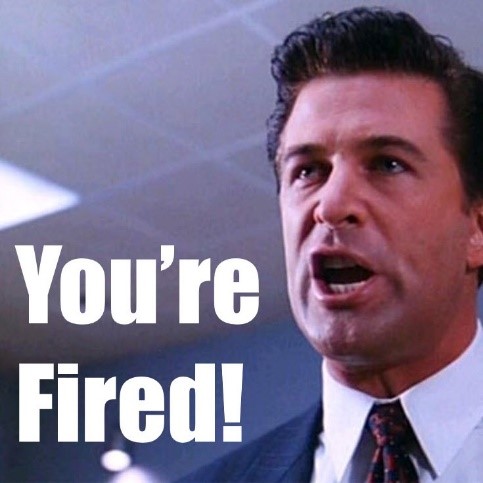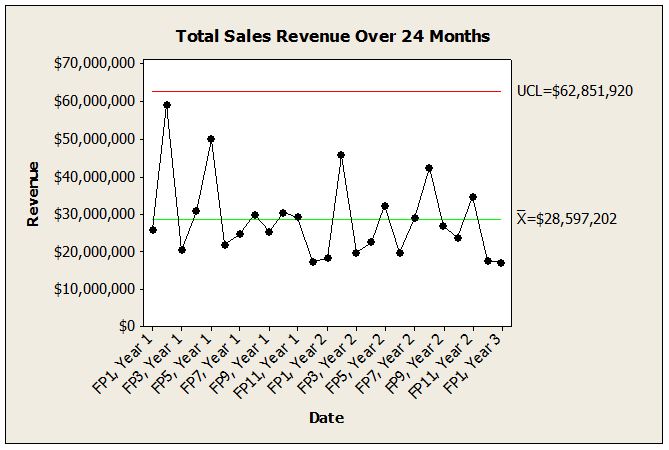SPIF Tip #31: Sales Problems Are Probably Not Caused By Your Sales VP
 Through the grapevine
Through the grapevine
I heard that the CEO at a company I’ll call “Blunder, Inc.,” wanted to fire his Sales VP.
Why? He missed his sales forecast.
Now this might not be politically correct, yet someone has to say it. Based on that information alone, the CEO should be fired, not the Sales VP.
Senior executives behave this way every day. Yet this behavior is inexcusable. Let me explain.
Any organization is a system – a set of elements assembled to accomplish a specific purpose. Scientific methods enable the behavior of systems to be understood and predicted. When executives make decisions outside the context required by systems thinking, albeit unwittingly, they are behaving incompetently.
Consider the tank of propane you use to fuel a barbeque grill. To be sure, it is a simpler system than a sales organization. Yet they are both made of components assembled to accomplish a specific purpose.
Did you know that the motion of any specific molecule of propane inside that tank is totally unpredictable? Even with all our technologies. The journeys of the molecules are random. Despite their individual randomness, the behavior of molecules as a whole can be predicted with great precision. In fact, mathematical laws explain their behaviors.
Here is a wonderful fact. Systems comprised of unpredictable elements can produce predictable phenomena in the real-world. We can predict how the temperature in the tank will increase with pressure, and vice versa. We know the behavior of the molecules will follow statistical distributions (e.g. binomial, normal, Poissons, etc.)
Now consider selling at Blunder, Inc. No one can predict with certainty the outcome of a specific sales opportunity. No matter what salespeople claim, they cannot control their customers. Just like gas molecules, sales outcomes contain randomness.
This is not to say performance overall cannot be predicted or improved (far from it). It is merely to say that the collective behavior of the system can be predicted easily and mathematically. Consider these sales results based on a real company, presented in the form of a process control chart[1]:
I can hear you thinking: “If our revenues seemed to be going down like that, our CEO would want them higher too. What is the point of putting revenue figures on a chart?”
The point is to help you see systemic behavior (often referred to as common cause[2] variation) as opposed to individual behavior. The chart reveals the demonstrated capability of this system. Properly collected and analyzed, this kind of data proves many things about an organization. For instance,
- As you can see, there is quite a lot of variation. It is virtually certain future sales results will continue to vary as indicated on the chart (unless some special cause[3] intervenes).
- The process is capable of averaging about $28.6 million per month. The chance of selling more is just as good as the chance of selling less.[4]
The CEO might demand the Sales VP achieve a target that is higher than the demonstrated capability of the system. The Sales VP might have little choice but to accept this demand. How can the Sales VP achieve this new target? Usually, by trying to get his or her sales team to work even harder (and “smarter”) than ever before.
Ironically, this is why sales and marketing productivity improvement is so dismal across B2B companies today:
- 62% of companies had difficulty making target revenues in 2014 (Forrester Research)
- 42% of all sales opportunities end in No Decision (HubSpot)
- A pass bet at a craps table has better odds than the average sales forecast (CSO Insights)
- B2B companies increasingly avoid engaging with salespeople until most of their decision-making process is complete (Google and the CEB)
Based on this industry data, perhaps there is no wonder the average turnover of salespeople across all industries is around 40%!
Why Doesn’t Sales Productivity Improve?
Companies tend to put their best and brightest minds to work on sales and marketing problems. They spend millions on sales training, CRM, lead generation, compensation changes, and many other things. Yet sales and marketing productivity remains one of the largest and most uncontrollable expenses on most companies’ income statements. Why?
Edwards Deming had a good explanation. He liked to illustrate it with a simple equation. He would say:
Suppose X + Y = 8
Where X = the individual, Y = the system, and 8 is the output of your system.
Senior executives often assume Y = 0.
They conclude therefore that performance is primarily a function of individuals.
Unfortunately, the exact opposite is a lot closer to the truth. The output of an organization is far greater than the sum of its parts. The input of any individual has only a tiny impact on the output of the whole. Especially in sales organizations, where in most companies there are lots of opinions and emotions rule.
Consider your own company’s situation. Are your sales problems caused by the market? The marketing? The sales force? Servicing? The product? Or something else?
And perhaps most importantly, how do you know this? Has anyone within your organization systematically gathered the data and evidence needed to identify the root causes of your company’s sales problems?
Or is everyone too busy trying to make the numbers to spend time doing this?
If you don’t have good answers to these questions, you are not alone. Most sellers and marketers are talented, well-intentioned people working their guts out to improve as individuals. Unfortunately, none of them have a complete picture of their business. Each manager has their own perspective. No one cultivates a shared, data-driven view of the system. Most don’t even know they need such a thing.
Instead, they focus on results only. And this is why conflicting opinions about causes of sales problems cannot be resolved. (Should you invest in better branding, additional salespeople, or a new CRM? How do you tell what changes will create improvement? Whose opinion counts, and whose doesn’t?)
This is why executives rely on the usual fixes year after year. It is why they accept the fact that sometimes results improve and other times they don’t. And, when that is no longer acceptable, it is why CEOs assume replacing the Sales VP is a solution, when it probably isn’t.
Such executives fail to understand they are dealing with a system. They are trapped in a mindset where people are the primary problem. In reality however, the system those people live in accounts for the vast majority of the system’s performance. They assume the performance of the system will improve without also having an explicit method for doing so.
Process Excellence Solves Sales and Marketing Problems
What are the requirements of an explicit method for improving sales and marketing? The same as they are for any other production system.
The first requirement is that individuals are able to observe reality and define their terms for themselves. Who is the customer? What is a qualified prospect? How do you know? Sellers and marketers already know they need nuanced answers to these kinds of questions. Unfortunately, no one has ever shown them how to operationally define their terms, or why they need to be maintained.
The second requirement is for an environment where people are encouraged to share they’ve learned, and to improve together through experiments. The process control chart reveals precisely the results that no single individual in the organization can improve. Without an explicit method for improving the system, no one acting alone – not the CEO, not the Sales VP, and certainly none of the salespeople – can have any sustainable positive effect on the performance of the system. Period. Full stop.
An explicit method for improving enables people to work together more effectively. They gather data revealing the common, high impact issues facing the business. They conduct experiments to learn and improve performance. They align finding, winning, and keeping customers to what their customers are actually doing to solve their own problems. Process control charts reveal the changes in the system’s performance.
Rational approaches such as this enable companies to achieve things managers did not know were even possible before:
- Instead of trying to sell every prospect they could find, a chemical company discontinued samples to low quality prospects. Sales rose 23%.
- A water filtration manufacturer created a new dealer sales process that reversed a four year sales decline.
- An auto aftermarket firm with declining market share became the market leader, hitting its five year plan in four years.
- A company selling hospital respirators increased sales productivity 30% in six months.
- An accounting software company’s forecast accuracy exceeded 90%.
- Better prioritization of deal flow at a machine tool company increased margins by 1% without raising prices. Profit increased nearly a million dollars annually.
Obviously, personnel decisions as important as those around the Sales VP and CEO involve a lot of context, and a lot of thought. They should not be based on whether or not the sales department hit some arbitrary target forecast. The randomness in any organization makes that nothing more than a crap shoot.
Instead, such decisions should be based on more fundamental questions, like “Why don’t we have numbers and data telling us the causes of our sales and marketing problems? Why don’t we have a method for improving our process and sales productivity?”
Installing a new Sales VP will not produce a method for improving in any business. However, installing a proper method for improving tends to add twenty or thirty IQ points to everyone involved in any business that does so.
+++++++
I’d like to thank Cliff Norman of PKP Inc., for his comments on this article, and for providing the Deming reference mentioned.
About the Author
More than twelve years ago, with deep experience in field sales, sales management, and sales training, Michael Webb set out to create a data-driven, process-based alternative to the offerings of typical sales training, sales consulting, and CRM companies. Since 2002, he has published numerous articles on ways B2B sales organizations can benefit from process improvement techniques, and consulted with companies like All Printing Resources, Burr Oak Tool, Danfoss, Wacker, Pentair, as well as many other B2B companies.
His newest book, Sales Process Excellence earned the Shingo Research Award in 2015. Learn more at www.salesprocessexcellence.com. Michael can be reached at www.salesperformance.com/contact-us
[1] A graph used to study how a process changes over time.
[2] Variation caused by the characteristics of the system you are measuring.
[3] Variation caused by a disturbance or influence outside the system you are measuring, such as a new competitive threat, a shortage of raw material, or a change in market demand.
[4] The green line represents the mean (average), which is about $28.6 million.


